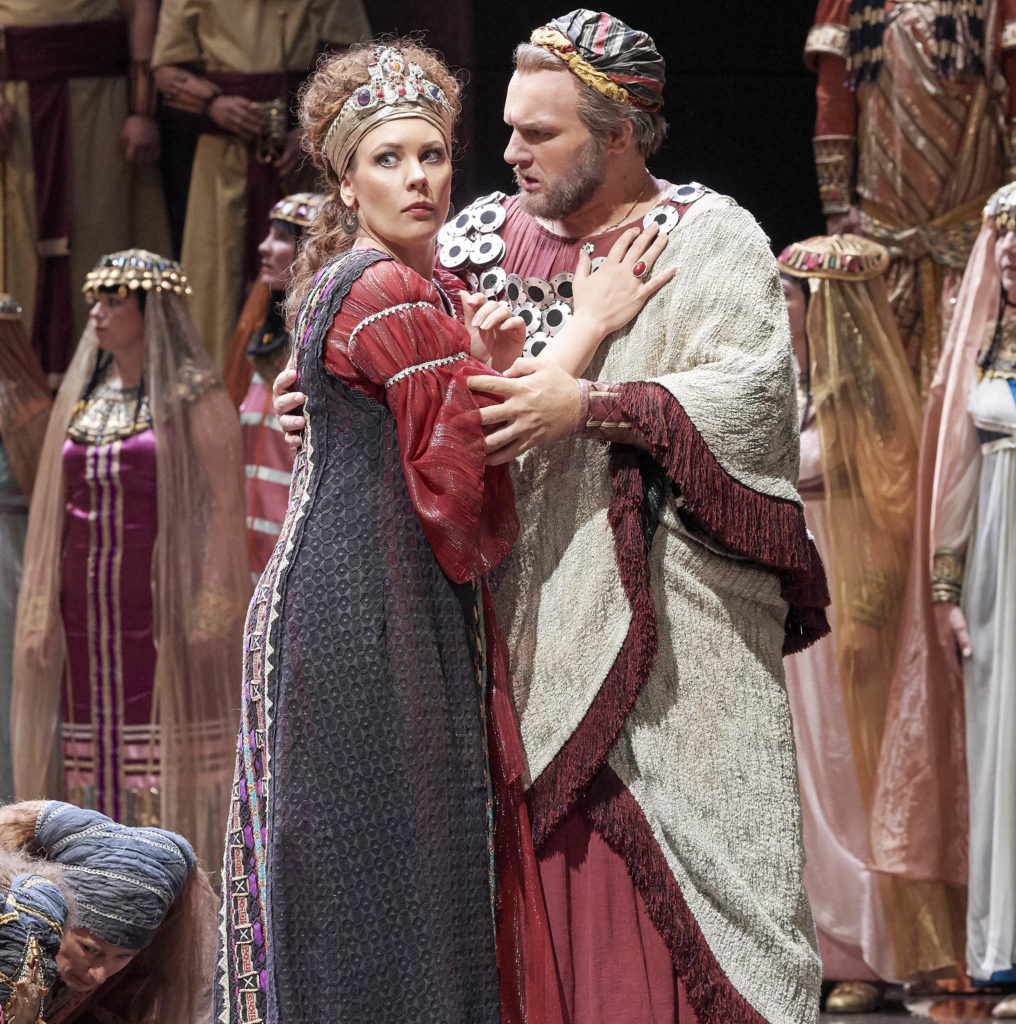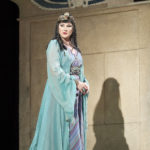 Another Aida at Vienna State Opera. Still those magnificent sets (Nicolas Joel), monumental, hardly to be bettered. Verdi’s Aida is famous for its set pieces, the great processions in Acts 1 and 2. The background is Egypt, threatened by Ethiopian forces, preparing for war. Opening, high priest Ramfis is talking to Radames (Gregory Kunde), the captain predestined to lead the army; and the King about to appoint his commander. But the public spectacle – however awesome- is not all what the opera is about. Behind the scenes, the drama is played out by the main characters, keeping up appearances, driven between private passions and public duty. So Radames seeks military glory, but is obsessed with Aida, the enslaved daughter of the Ethiopian King. While Radames, in turn, is loved by Amneris, the Egyptian Princess who suspects Aida as her rival. And Aida is torn between her secret love for Radames, and loyalty to her fatherland and King.
Another Aida at Vienna State Opera. Still those magnificent sets (Nicolas Joel), monumental, hardly to be bettered. Verdi’s Aida is famous for its set pieces, the great processions in Acts 1 and 2. The background is Egypt, threatened by Ethiopian forces, preparing for war. Opening, high priest Ramfis is talking to Radames (Gregory Kunde), the captain predestined to lead the army; and the King about to appoint his commander. But the public spectacle – however awesome- is not all what the opera is about. Behind the scenes, the drama is played out by the main characters, keeping up appearances, driven between private passions and public duty. So Radames seeks military glory, but is obsessed with Aida, the enslaved daughter of the Ethiopian King. While Radames, in turn, is loved by Amneris, the Egyptian Princess who suspects Aida as her rival. And Aida is torn between her secret love for Radames, and loyalty to her fatherland and King.
Magnificent though the ceremonial may be, the great opening procession, (Su del Nilo al sacro Lido) in Act 1, seems a little top-heavy- those elaborate, authentic-looking costumes. Especially for the cast in the record temperatures of a heatwave in Vienna. So even with State Opera’s air con, the familiar pomp seems a little tedious. (Ouch!)  Until the Radames Celeste Aida aria, in which he hopes, as victor, to be able to marry Aida, (yet an Ethiopian slave.) Gregory Kunde’s thrilling tenor- convincingly Italianate in intonation- was a highlight of the evening. Kunde’s Radames has nobility and dignity, yet his secret love is doomed.
Until the Radames Celeste Aida aria, in which he hopes, as victor, to be able to marry Aida, (yet an Ethiopian slave.) Gregory Kunde’s thrilling tenor- convincingly Italianate in intonation- was a highlight of the evening. Kunde’s Radames has nobility and dignity, yet his secret love is doomed.
Ethiopia’s invasion is announced, Radames to lead the Egyptian forces, Amneris, the Pharaoh’s daughter, desperately in love with Radames, proclaims in her aria Ritorna vincitor! But Ekaterina Gubanova’s mezzo is not robust enough; there’s not enough power in a role historically for big, dramatic, mezzo-sopranos. She sings expressing her feelings to Radames and is rebuffed. But when Aida enters, Amneris observes Aida’s confusion when she sees Radames.
As the despondent Aida, Elena Guseva’s Scene 1 aria doesn’t quite hit the heights. Return victorious! She too has said it. But his victory, his triumph, would be over her brothers. Yet she’s tormented, cannot forget she loves him. What anguish! When she can’t return to her father, (Ethiopia’s King, no less), and family. Aida’s distress is observed by the jealous Amneris exuding false charm. In the trio, Guseva sings movingly, confessing she weeps not just for her country, but for an undying love.
In the seductive ballet sequence, opening Act 2, Amneris is being dressed for the victory celebrations. Overlooked by towering, pyramid-like sandstone structures, statuesque figures, apparently naked, their skin mummified in gold paint, come alive in Vienna State Ballet’s graceful choreography. Gubanova, a slight figure, does have stage presence.  In her aria awaiting Radames, she’s troubled by doubts about Aida. Is she really her rival? But though competently sung, her mezzo, in this role, isn’t interesting enough. ” A lot of different vocal colouring must make the complex character of the princess credible”, (according to Vienna’s programme notes.) So in her (Scene 2) duet with Aida – which should be a powerhouse of drama- she lacks heft. Their famous duet, in which Aida is coaxed into revealing her love for Radames, though well sung, doesn’t have the electric charge, between these passionate rivals. This was a low burn.
In her aria awaiting Radames, she’s troubled by doubts about Aida. Is she really her rival? But though competently sung, her mezzo, in this role, isn’t interesting enough. ” A lot of different vocal colouring must make the complex character of the princess credible”, (according to Vienna’s programme notes.) So in her (Scene 2) duet with Aida – which should be a powerhouse of drama- she lacks heft. Their famous duet, in which Aida is coaxed into revealing her love for Radames, though well sung, doesn’t have the electric charge, between these passionate rivals. This was a low burn.
But. after the freeing of the slaves (at Radames request), Guseva, in Aida’s long aria, was impressive- lamenting ( O Patria mia ), she’ll never see her homeland again. Guseva was warmly received. Outstanding was Aida’s reunion with her father, the King (Simone Piazzola) disguised amongst the other slaves, begging for their freedom; also the climax with Radames, in his aria, torn between love and duty.
But, as always in Aida, it’s as much the magnificent choruses, ( Vienna State Opera’s and extra choirs), that are important. The triumphant welcome home for victorious Radames, Gloria all’egitto, is like a 1930’s Cecil B. DeMille Hollywood set, within Vienna’s huge stage. Costumes in Joel’s production (first seen 1984) are to be-wonder, in their ornate, luxurious finery, richly exotic colours. And those Priests in their cream top hats! (Radames is crowned and offered anything he wishes.) ![06_Aida_121736_PIAZZOLA[1]](https://viennaoperareview.com/wp-content/uploads/2019/08/06_Aida_121736_PIAZZOLA1-150x150.jpg) If the spectacle seemed too much of a good thing, the juxtaposition of the private narratives of the main characters played out against the crowd scenes is what Verdi intended.
If the spectacle seemed too much of a good thing, the juxtaposition of the private narratives of the main characters played out against the crowd scenes is what Verdi intended.
So in Acts 3 and 4, the external spendours of grand opera recede, and the focus is on “the tormented humanity of the protagonists.” In Act 3, Amonasro has followed Aida come to meet Radames. Invoking the suffering of his people, conjuring up idyllic memories of their homeland, he tries to persuade Aida to get Radames to reveal the Egyptians’ plans. The Aida-Amonasro duet is quite outstanding. Piazzola somehow looks too young, and too good-looking to be her father, no matter. His ‘big, sensuous, agile baritone’ only appears in a few scenes, notably convincing the Pharoah he’s witnessed ‘King Amonasro’s death’. Now his beguiling rhetoric backfires, when Aida realises he’s intent on getting her to betray Radames. Her father angrily pushes her down. Guseva’s Aida cowers front of stage, as the Ethiopian King reminds her, she’s betraying her country, and for what? High drama, played out on a darkened, nocturnal stage, with only an upturned sphinx as prop.
Then, the Aida-Radames duet. In an equally powerful scene, Aida has to persuade Radames to flee with her. Radames – Kunde the other outstanding singer of the evening- remonstrates. She’s asking him to abandon his country, he, the celebrated victor over the Ethiopians, (her people, of course.) Somehow, using her charm, she does convince him to escape; she’s in love with him, after all. Maybe she actually thinks the only way out is exile? So he reveals ‘a path safe from the Egyptian army’. But overheard by Amonasro, in hiding, who emerges triumphant to reveal he’s the King (presumed dead). Of course, Radames will be rewarded…
But Radames takes exception, will not betray his country. This is the nub of the opera- a theme common to many Verdi operas, from Nabucco to Don Carlo : ” Does love for another transcend love for one’s fatherland?” Private happiness has to be subordinated to the common good. So Radames gives himself up to the guards, realising he’s been duped, and the enormity of his disclosure. (Amonasro and Aida flee, Radames, charged with high treason, condemned to death.)
Yet Amneris still loves him, desperately proclaiming his innocence, she accuses the High Priest and court of making a mistake. Gubanova is over-emotional, and her mezzo, though very competent, isn’t nuanced enough to hold the scene. Amneris is an example of how far those in power are prepared to abase themselves for love. (She a princess, he a General – having an affair with a slave!)
In the nemesis, Radames is joined by Aida in a death vigil – interned alive in an underground vault. The cell, in Carlo Thomasi’s set, resembles a concrete bunker. Outside sits the forlorn figure of Amneris. Aida sings to Radames of her vision of paradise. Morir! Si pura e bella. They are seen in one another’s arms, the unforgettably haunting O terra addio, tenderly sung by Guseva and Kunde, never fails to move.
Marco Armiliato ‘s conducting showed off Vienna State Opera orchestra in Verdi’s almost ‘symphonic’ score, with oriental-sounding instrumentation and melodies. And Vienna’s robust Choruses, thrillingly idiomatic. © P.R. 26.6.2019
Photos: Elena Guseva (Aida), Simone Piazzola (Amonasro); Gregory Kunde (Ramades); Ekaterina Gubanova (Amneris); Simone Piazzola (Amonasro); Featured image Elena Guseva (Aida)
© Wiener Staatsoper/ Michael Pöhn

I discovered your weblog web site on google and examine a number of of your early posts. Continue to maintain up the very good operate. I just extra up your RSS feed to my MSN Information Reader. Looking for forward to studying extra from you afterward!?
Top site ,.. amazaing post ! Just keep the work on !